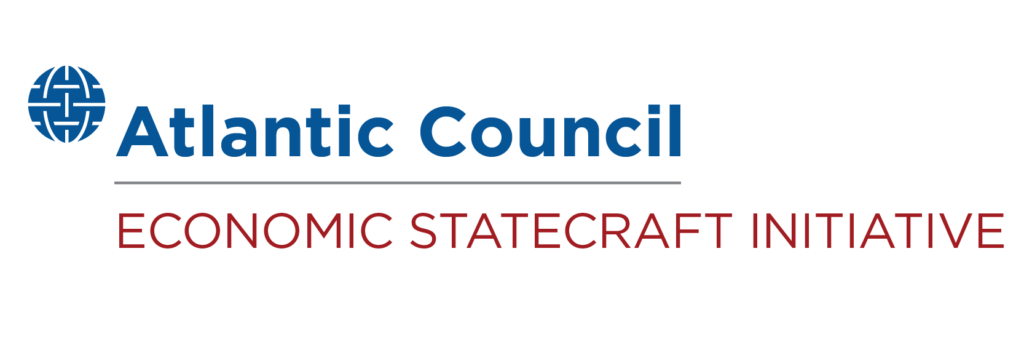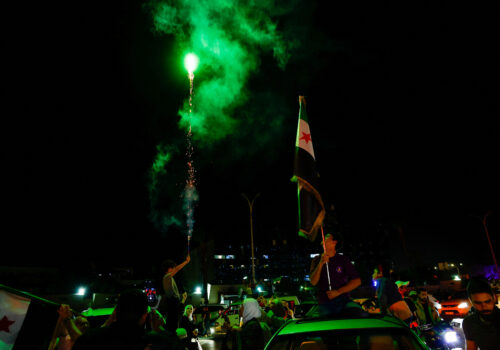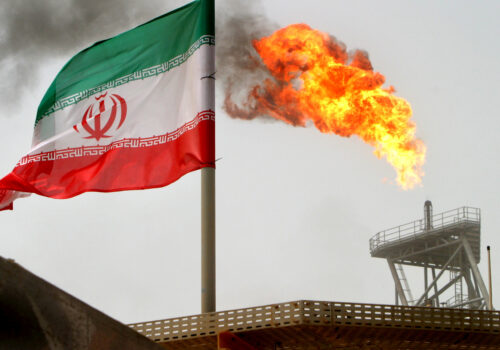Charting a strategic path for Syria’s postwar reconstruction
As Syria emerges from over a decade of conflict, easing sanctions by the United States, the European Union (EU), and other European partners is an important step toward reintegrating Syria into the global economy. Yet, for a country that has been economically isolated for over fourteen years, lifting sanctions is only the beginning.
The World Bank estimates Syria’s economy at around $21 billion, representing an 83 percent decline since 2010, while the United Nations (UN) estimates that the cost of reconstruction will be more than $250 billion. The road ahead is long.
Recent developments are encouraging. Syria has reengaged with the World Bank and International Monetary Fund (IMF) and reconnected with the European banking system. However, fostering stability and reconstruction requires international actors—particularly the United States—to pursue a coherent, positive economic statecraft strategy to anchor recovery in the long term. Without coordinated engagement, targeted investment, and clear policy direction, Syria remains vulnerable to corruption, deepening poverty, and adversarial influence seeking to fill the vacuum left by the collapse of the Assad regime.
Lifting US sanctions on Syria
US President Donald Trump’s recent executive order, “Providing for the Revocation of Syria Sanctions,” marks the first official step in lifting US sanctions on Syria. The order terminated previous executive orders imposing sanctions on the country. In response, the US Department of the Treasury’s Office of Foreign Assets Control (OFAC) lifted 518 designations, including for major Syrian banks and companies critical to infrastructure and rebuilding.
However, the executive branch is limited in what it can do. The Caesar Act, which codifies sanctions into law, requires congressional approval to lift any designations under its framework. Although the Caesar Act sanctions are temporarily waived for 180 days, this exception is set to expire in November 2025. The executive order directed the secretary of state to assess the potential for fully suspending sanctions under the Caesar Act, but the congressional process for lifting these sanctions may be slow and politically complex.
Additionally, the secretary of state recently announced the removal of all Hay’at Tahrir al-Sham (HTS) terrorism designations, after the group was disbanded earlier this year. Nevertheless, HTS remains listed under the United Nations (UN) sanctions. While the United States has drafted a UN resolution to begin the process of lifting UN sanctions, this may prove to be a slow process. Any delisting would require unanimous consensus from the UN Security Council, which is unlikely. While UN sanctions remain in place, financial institutions will continue to struggle with compliance issues when engaging with Syria.
Finally, while the executive order permits relaxing export controls of certain goods, the US Department of Commerce is yet to review or lift export controls, further complicating efforts by the private sector to reenter the Syrian economy.
While these policy changes by the US government are crucial, they are also complex and, on their own, insufficient to enable Syria’s reconstruction and stabilization.
Steps in the right direction
Announcements by the United States, the EU, and other European countries regarding the sanctions relief for Syria have generated significant momentum to reintroduce Syria into the global economy.
For the first time since 2009, the IMF has conducted a mission to Damascus. Their recommendations highlight the urgent need for sound fiscal and monetary policy, institutional strengthening, banking reform, and enhanced anti-money laundering and countering the financing of terrorism (AML/CFT) frameworks. These are foundational steps toward rebuilding confidence in Syria’s economic governance, which the Syrian authorities have expressed commitment to. The World Bank also recently approved a $146 million loan to restore Syria’s electricity infrastructure—a critical step for both economic productivity and civilian welfare.
Meanwhile, the EU’s easing of financial restrictions has enabled Syria to rejoin the SWIFT system, leading to its first electronic transfer in over a decade—signaling cautious reengagement from European financial actors.
With Trump’s executive order, US banks and the private sector are now positioned to reenter Syria too. However, reputational and political risks may temper initial enthusiasm, requiring the US government to lead the way.
Remaining challenges require positive economic statecraft
Even with fewer legal barriers, Syria is considered a complex and risky environment for many private sector actors. The country has been sanctioned in some form since 1979. After years of conflict and institutional erosion, a legacy of opaque regulatory frameworks, weak governance, and perceived instability remains.
Syria’s persistent presence on the Financial Action Task Force grey list underscores concerns about illicit financial activities and the country’s limited regulatory capacity. For the private sector, this listing signals elevated financial and operational risks, including increased regulatory burdens, reputational damage, limited financial access, and economic instability.
Further compounding this risk perception, the recent conflict escalation between Israel and Iran has heightened instability in the region and cast a shadow over Syrian investment opportunities. The United States’ military intervention in the conflict raises concerns about the coherence of US strategy in the Middle East. Meanwhile, escalating tension between Syria and Israel in recent days adds another layer of uncertainty threatening Syria’s prospects for peaceful and stable reconstruction.
While the easing of sanctions was intended to catalyze economic reintegration, the geopolitical landscape in the region may limit the speed and scale of private capital influx, unless it is underpinned by strategic support and risk mitigation. Given Syria’s historical strategic value, adversarial actors are also likely to try to maintain influence and investment there, making sustained constructive engagement by the United States and its allies essential.
A roadmap for US policy
To support Syria’s reconstruction and encourage responsible private sector engagement, the United States should pursue a more structured approach, beginning with the steps listed below.
- Ensure legal clarity for the private sector. Providing the private sector with structured guidance to navigate the evolving legal landscape of the Caesar Act, designations related to terrorism, and export controls will help US banks and businesses navigate regulatory complexities, ensuring compliance and reducing risks perceptions.
- Ensure legal and political clarity for the Syrian government. Ongoing communication with the Syrian government regarding the conditions and expectations tied to sanctions relief, as well as benchmarks for continued engagement, will facilitate smoother cooperation and reduce risk of backsliding.
- Continue diplomatic efforts within the UN. Ongoing diplomacy with the UN Security Council members regarding the lifting of HTS designations is essential to prevent jurisdictional arbitrage, uneven sanctions compliance and enforcement, and increased risk for the financial and private sector.
- Strengthen financial integrity. Providing technical assistance to enhance Syria’s AML/CFT compliance and to establish formal, regulated channels for investment and financial transfers would prevent the proliferation of informal systems prone to corruption, illicit finance, and state capture, and would reduce risks for financial institutions considering reentry.
- Leverage US International Development Finance Corporation (DFC) reauthorization to manage risk related to investment in Syria. The United States should use DFC reauthorization to create a strategic framework for investment in Syria, coordinating with institutions like the World Bank’s Multilateral Investment Guarantee Agency to provide insurance mechanisms that protect private investors from political and economic instability, while promoting transparency and policy consistency.
- Develop a task force with allies to support Syria’s reconstruction. Progress requires strategic alignment between the United States, EU, IMF, World Bank, and key regional actors, including the Gulf states. Considering the upcoming Annual Meetings of the IMF and the World Bank Group, the United States should seize the opportunity to develop a coordinating body to identify opportunities and solutions for Syria’s postwar reconstruction, ensuring reforms are sequenced, accountable, and achievable.
- Support diaspora and Gulf investment with oversight. Syria’s diaspora and investors based in the Gulf offer strong potential for recovery capital—but only if engagement is channeled through secure, regulated platforms that promote transparency and prevent capture by entrenched interests.
Syria’s recovery and reintegration into the global economy is strategically necessary for regional stability. Past experiences in Sudan and Libya offer cautionary tales about the how removing economic leverage can backfire when there are no clear reform benchmarks or defined positive economic statecraft strategies. If left unstructured and unsupported, Syria’s fragile recovery risks becoming opaque, corrupt, and ultimately reversible.
For the United States, this moment presents a rare opportunity to lead through coordination, clarity, and targeted assistance. Syria’s economic future—and by extension, a measure of stability in the broader Middle East—may well depend on Washington’s willingness to expand its toolkit beyond punitive economic measures and embrace more positive economic statecraft tools.
Kimberly Donovan is the director of the Economic Statecraft Initiative within the Atlantic Council’s GeoEconomics Center. She is a former senior Treasury official and National Security Council director.
Jonathan Panikoff is the director of the Atlantic Council’s Scowcroft Middle East Security Initiative and a former deputy national intelligence officer for the Near East at the US National Intelligence Council.
Lize de Kruijf is a program assistant at the Atlantic Council’s Economic Statecraft Initiative within the GeoEconomics Center.
Manal Fatima is an assistant director at the Atlantic Council’s Scowcroft Middle East Security Initiative.
Note: The insights and recommendations presented in this piece emerged from a private roundtable held in June, co-hosted by the Atlantic Council’s Economic Statecraft Initiative and the Scowcroft Middle East Security Initiative. We extend our sincere thanks to all participants for their valuable contributions and for helping shape the ideas reflected here.
Related content

Economic Statecraft Initiative
Housed within the GeoEconomics Center, the Economic Statecraft Initiative (ESI) publishes leading-edge research and analysis on sanctions and the use of economic power to achieve foreign policy objectives and protect national security interests.



